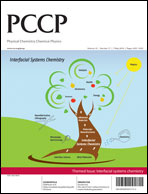Self-assembled monolayers (SAMs) fabricated on Au(111) substrates from a homologous series of pyridine-terminated organothiols have been investigated using ultra high vacuum infrared reflection adsorption spectroscopy (UHV-IRRAS), X-ray photoelectron spectroscopy (XPS), scanning tunnelling microscopy (STM) and near-edge X-ray absorption fine structure (NEXAFS) spectroscopy. A total of 4 different pyridine-based organothiols have been investigated, consisting of a pyridine unit, one or two phenyl units, a spacer of between one and three methylene units and, finally, a thiol unit. For all pyridine-terminated thiols the immersion of Au-substrates in the corresponding ethanolic solutions was found to result in the formation of highly ordered and densely packed SAMs. For an even number of the methylene spacers between the SH group and the aromatic moieties, the SAM unit-cell is rather large,  , whereas in case of an odd number of methylene units a smaller unit cell is adopted,
, whereas in case of an odd number of methylene units a smaller unit cell is adopted,  . The tilt angle of the molecules amounts to 15°. In contrast to expectation, the pyridine-terminated organic surfaces exposed by the corresponding SAMs showed a surprisingly strong resistance with regard to protonation.
. The tilt angle of the molecules amounts to 15°. In contrast to expectation, the pyridine-terminated organic surfaces exposed by the corresponding SAMs showed a surprisingly strong resistance with regard to protonation.

You have access to this article
 Please wait while we load your content...
Something went wrong. Try again?
Please wait while we load your content...
Something went wrong. Try again?
 , whereas in case of an odd number of
, whereas in case of an odd number of  . The tilt angle of the molecules amounts to 15°. In contrast to expectation, the
. The tilt angle of the molecules amounts to 15°. In contrast to expectation, the 

 Please wait while we load your content...
Please wait while we load your content...